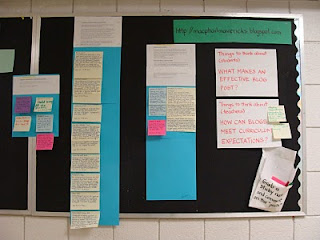

Rodd Lucier at The Clever Sheep blog, about 3 posts ago, wrote about "Paper Blogging". He saw an example of a bulletin board transformed into a hallway blog when he was at another school. He posted photos of the example and explained how the teacher at that school used the sticky note interaction to discuss why some authors moderate their comments, how people can deal with negative or anonymous comments, and other interesting issues.
I thought this was pretty innovative. My own junior division blog was a bit lethargic, and the students weren't using it as effectively as I would have liked, so I actually replicated our online blog on a bulletin board in a busy hallway. I copied the already-existing comments onto sticky notes, printed original blog posts and supplied extra markers and sticky notes so that people passing by could make new comments. We had great discussions in the library about which version was read more, the differences between the online and paper version, and other thoughtful questions. I will try and post some of the things the students said later this week on the blog.

On March 30, I gave a half-way workshop for a family of schools in the Dufferin-Peel Catholic District School Board on how to implement the OSLA document, "Together For Learning". This was a delightful group of teacher-librarians. Before meeting them, I surveyed the group using Survey Monkey to get a feel for their team and what their most pressing needs were. Out of the four key components of a learning commons (flexible physical & virtual space / learning partnerships / equitable access / integration of technology), the technology piece was the most challenging. The teacher-librarians have a lot of restrictions placed upon them in terms of bringing in technology (no personal laptops for teachers, few computers per pupil, many centrally blocked sites, etc.). As part of the talk and activities (called "Making Lemonade in the Library Learning Commons" - the Prezi can be found at my personal wiki), we used Bitstrips for Schools (licensed for all educators in Ontario), which was not blocked, and I showed them pictures of my paper blog. At the end of the session, as we drank lemonade from our plastic champagne glasses, I asked the group what their next step would be. Many of the participants said they would like to do a version of the paper blog, because even though they could not add a dozen more computers to their lab, by trying this activity, they could at least simulate the technology.
So, thanks to a link via Twitter, now teachers in at least three different school boards are trying out paper blogging, for different reasons but for similar purposes - to help student learning. Pay it forward - share your ideas, share the ideas of others, and you never know who it will help.

Thanks for continuing to pay it forward Diana. I have to say, I love the explanations and questions you've included. "What is a Blog?" and "What makes an effective blog post?" are both questions that serve to remind readers that writing in public is very different than writing for an audience of one.
ReplyDeleteContinued success!
Rodd, I can't even take credit for the "what makes an effective blog post" question - that was borrowed directly from Danika Barker. What I hope to do is look at how her grade 11 students answered that question and compare it to how my grade 5-6 students answered. I'd love to see the similarities and differences.
ReplyDeleteWhat a really cool idea! There are many schools and public libraries that I talked to who are interested in going online but fear liability issues with kids and tweens. I think this paper version of a blog will help them understand how the mechanism works. I bet the kids love it too!
ReplyDelete